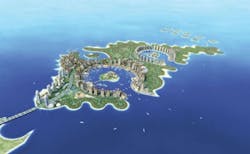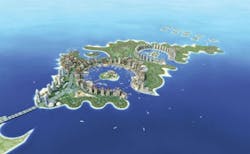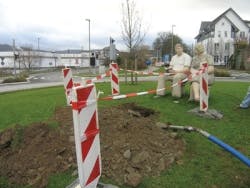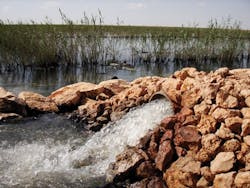Near Source Pollution Control – Low-Cost Water Quality Management
By Chris Williams
• New technology based on smaller local filtration control could provide significant capital investment benefits toward resolving problems of controlling pollution due to stormwater runoff.
The passing of the Water Framework Directive (WFD) by the European Parliament and Council of Ministers has meant that an integrated approach to catchment management would be adopted across Europe. The overriding requirement being that all rivers achieve "good" status by 2015. In addition, there's a common consensus this be achieved by a combined approach of:
- Quality objective-setting, and
- Source control through best available techniques.
Stormwater runoff is underestimated as a source of many undesirable pollutants. It isn't only the water utility companies with responsibility in meeting WFD requirements, but also that of highways authorities/agencies and every facility with a parking lot. Much of river and aquifer quality degradation can be attributed to diffuse pollution from urban (and rural) roads and highways as well as parking lots, where drainage infrastructure either directly connects to a receiving watercourse or discharges to an aquifer through percolation.
Removing pollutants at the earliest possible stage in the treatment process offers advantages for cost and water quality in the same way that near-source stormwater attenuation offers a best-value solution to flood water management. Combining storage, control and treatment also provides a "treatment-train" approach advocated by national sustainable urban drainage systems (SUDS) manuals.
Recent work in the USA has examined the volume and type of pollutants in stormwater and developing a small footprint, low maintenance filtration solution that can be targeted at identified contamination sources. The new technology could offer an important solution to meeting WFD requirements for controlling pollution as close as possible to its point of entry into the drainage system.
Orakei Marina development's upgrade at Okahu Bay near Auckland on New Zealand's Hauraki Gulf – with 172 new berths and over three acres of development, including a car park and gardens – required a novel stormwater management approach due to a shallow drainage system. Developer agent Hynds Environmental turned to Hydro International to meet strict environmental requirements with a system that removes >90% of particles with a mean particle distribution of 20 µm.
Achieving control of particulate matter and sediments in stormwater runoff has been identified as critical where the runoff source has a high potential pollutant load. "Hot spot" areas like highways, car parks, petrol stations and service stations, public works storage and waste recycling areas pose the greatest risk, alongside many industrial sites. Introducing settlement ponds to help control sediments (used here as a blanket term for all floating, suspended, fine and coarse matter included in the runoff) would be impractical in most of these locations. Even if space could be found, the cost of land and regular maintenance would be prohibitive in many cases.
Washing in pollution
Pollutants entering the stormwater system due to surface runoff are many and various. Monitoring undertaken in the USA has identified some of these pollutants as suspended and other solids, phosphates, ammonia and nitrates, phenols, aluminium, cadmium, copper, chromium, lead and zinc. Some of these are included in the list of priority substances that form Annex X of the WFD.
Collating results of several projects over two decades demonstrates that concentration can vary immensely, depending where samples are taken (see Table 1). The sources of contamination can be complex. Pollutants can be incorporated by several different mechanisms. They can be collected from the atmosphere by rain (i.e., wet processes) or as wind transported dust subsequently washed from the surface as runoff.
For example, one source of zinc is from vehicle tires, still widely used for road vehicles. Since these studies, lead has been largely removed from petrol and concentrations have dropped markedly over the years since the study. Metals, particularly heavy metals, are still generally of high interest because of their persistence and possible toxicity when accumulated in ecological systems.
Particulate association
Work published in 2005 demonstrated the association of metal pollutants with particles in urban runoff, and looked at the distribution of metal concentration with particle size, as well as the presence of metals in dissolved and colloidal bound forms. Overall, this showed filtration of particles from the stormwater samples, even at relatively large sizes (20 μm) removed many important pollutants such as total phosphates, most heavy metals such as lead, copper and cadmium, also zinc – but was less effective in removing nitrates. Comments on the use of settlement ponds for this runoff indicated that small ponds could be expected to remove particles down to 20 μm while larger ponds could achieve 5 μm or a little better. The disadvantage of ponds is the large land area needed to achieve high level particulate removal.
New filtration solution
New technology developed under the U.S. Environment Protection Agency's Small Business Innovation Research Programme and further refined by Hydro International demonstrates a small footprint filtration device can provide highly effective filtration and treatment for specific classes of stormwater pollutants. Designed and patented by Dr. Bob Pitt of The University of Alabama, the device, known as the Up-Flo™ filter, has been extensively field tested and undergone full-scale lab trials in the USA. It also was successfully deployed recently to ensure runoff from a new marina near Auckland, New Zealand's pristine Hauraki Gulf, famous for hosting the America's Cup yacht race, didn't adversely affect area water quality.
The Up-Flo technology offers a low-cost solution to near-source sediment and pollution control as it combines course screening, sedimentation and high-rate filtration in a single device, offering an entire treatment train approach. The system takes incoming stormwater and directs it up through filter medium modules. The filter modules with pre-bagged media are sited around the outlet of the chamber. During a rain event, stormwater enters the filter chamber via an inlet pipe or surface inlet grate. Gross debris and sediment settle out in the sump. Buoyant or floating debris is removed by an angled screen before flows are directed up the filter module and on to the downstream sewer.
The design enables a choice of different filtration media to be used appropriate to local pollution conditions. It has high flow rates, low head loss and operates without power. The system of bagged filtration media ensures minimum maintenance and the sump can be cleaned of floatables and sediment with a standard gully cleaner, so whole life costs are very low.
Effective performance
Advantages are that the whole area of the filter and medium is used for more effective filtration than down-flow filtration and longer life of the media reduces costs. A high filtration rate per square meter also enables high flow rates and thus lower footprint than conventional pond or vegetative treatment systems, allowing development areas to be maximised without compromising the environment.
In addition, the drain-down water level washes pollutants out of the filter media into a sump, preventing blinding and improving filter life for reduced maintenance, as well as allowing the filter media to dry out between storm events and ensuring system effectiveness and longevity.
The field and lab trials show that particles are effectively removed, with at least 50% of removed particles in the 1-10 μm range removed, and 95% in the 30-250 μm segment. Add in the range of filtration media that can be incorporated to treat or adsorb specific pollutants – e.g., ammonia or hydrocarbons – and the value of the system is apparent.
Extended benefits
Now low cost, high-rate filtration separation technology offers a solution that meets the combined approach requirements of the WFD, in a footprint little bigger than a conventional manhole and gully pot; and variable in size to fit the flow regime.
It can take the benefits of a source control approach with relatively low cost modification to the existing sewerage infrastructure, and make it more tailored to local problems, be they industrial (hydrocarbons, metals etc), people related (food, faecal etc), horticultural (ammonia, nitrates, phosphates etc) or automotive (zinc, lead, hydrocarbons etc).
By combining Up-Flo's better and more economical filtration of a wide range of particulate matter and associated pollutants with the vortex control of the Hydro-Brake® Flow Control unit, full use can also be made of storage capacity of existing infrastructure. This could save millions in new plant and improve river or aquifer quality to meet WFD requirements within a very short time.
Author's Note: Chris Williams is COO and managing director in Europe for Hydro International, a filtration systems and stormwater management specialist with headquarters in Portland, Maine, USA, and offices also in the UK and Ireland. Williams is based in Clevedon, Wales, UK. Contact: +44 (0) 1275 878371, [email protected] or www.hydro-international.biz
More Water & WasteWater International Issue Articles
More Water & WasteWater International Archived Issue Articles




